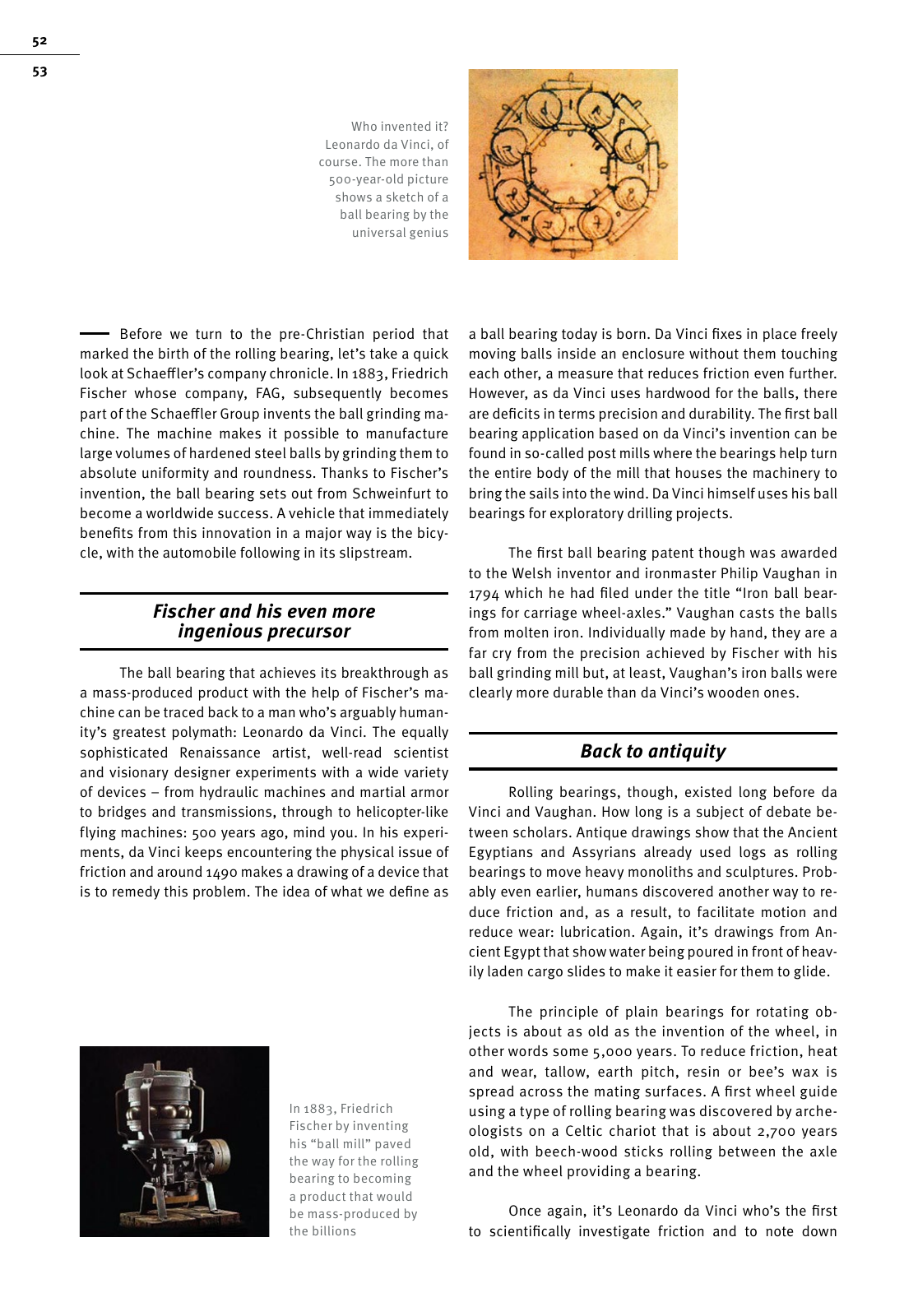Before we turn to the pre Christian period that marked the birth of the rolling bearing let s take a quick look at Schaeffler s company chronicle In 1883 Friedrich Fischer whose company FAG subsequently becomes part of the Schaeffler Group invents the ball grinding ma chine The machine makes it possible to manufacture large volumes of hardened steel balls by grinding them to absolute uniformity and roundness Thanks to Fischer s invention the ball bearing sets out from Schweinfurt to become a worldwide success A vehicle that immediately benefits from this innovation in a major way is the bicy cle with the automobile following in its slipstream Fischer and his even more ingenious precursor The ball bearing that achieves its breakthrough as a mass produced product with the help of Fischer s ma chine can be traced back to a man who s arguably human ity s greatest polymath Leonardo da Vinci The equally sophisticated Renaissance artist well read scientist and visionary designer experiments with a wide variety of devices from hydraulic machines and martial armor to bridges and transmissions through to helicopter like flying machines 500 years ago mind you In his experi ments da Vinci keeps encountering the physical issue of friction and around 1490 makes a drawing of a device that is to remedy this problem The idea of what we define as a ball bearing today is born Da Vinci fixes in place freely moving balls inside an enclosure without them touching each other a measure that reduces friction even further However as da Vinci uses hardwood for the balls there are deficits in terms precision and durability The first ball bearing application based on da Vinci s invention can be found in so called post mills where the bearings help turn the entire body of the mill that houses the machinery to bring the sails into the wind Da Vinci himself uses his ball bearings for exploratory drilling projects The first ball bearing patent though was awarded to the Welsh inventor and ironmaster Philip Vaughan in 1794 which he had filed under the title Iron ball bear ings for carriage wheel axles Vaughan casts the balls from molten iron Individually made by hand they are a far cry from the precision achieved by Fischer with his ball grinding mill but at least Vaughan s iron balls were clearly more durable than da Vinci s wooden ones Back to antiquity Rolling bearings though existed long before da Vinci and Vaughan How long is a subject of debate be tween scholars Antique drawings show that the Ancient Egyptians and Assyrians already used logs as rolling bearings to move heavy monoliths and sculptures Prob ably even earlier humans discovered another way to re duce friction and as a result to facilitate motion and reduce wear lubrication Again it s drawings from An cient Egypt that show water being poured in front of heav ily laden cargo slides to make it easier for them to glide The principle of plain bearings for rotating ob jects is about as old as the invention of the wheel in other words some 5 000 years To reduce friction heat and wear tallow earth pitch resin or bee s wax is spread across the mating surfaces A first wheel guide using a type of rolling bearing was discovered by arche ologists on a Celtic chariot that is about 2 700 years old with beech wood sticks rolling between the axle and the wheel providing a bearing Once again it s Leonardo da Vinci who s the first to scientifically investigate friction and to note down Who invented it Leonardo da Vinci of course The more than 500 year old picture shows a sketch of a ball bearing by the universal genius In 1883 Friedrich Fischer by inventing his ball mill paved the way for the rolling bearing to becoming a product that would be mass produced by the billions 52 53

Hinweis: Dies ist eine maschinenlesbare No-Flash Ansicht.
Klicken Sie hier um zur Online-Version zu gelangen.
Klicken Sie hier um zur Online-Version zu gelangen.